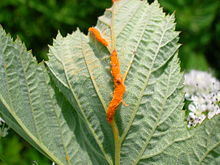- Filipendula ulmaria
-
Meadowsweet Scientific classification Kingdom: Plantae (unranked): Angiosperms (unranked): Eudicots (unranked): Rosids Order: Rosales Family: Rosaceae Genus: Filipendula Species: F. ulmaria Binomial name Filipendula ulmaria
(L.) Maxim.Filipendula ulmaria, commonly known as Meadowsweet, is a perennial herb in the family Rosaceae that grows in damp meadows. It is native throughout most of Europe and Western Asia. It has been introduced and naturalised in North America.
Juncus subnodulosus-Cirsium palustre fen-meadow plant associations of Western Europe consistently include this plant.[1]
Meadowsweet has also been referred to as Queen of the Meadow, Pride of the Meadow, Meadow-Wort, Meadow Queen, Lady of the Meadow, Dollof, Meadsweet, and Bridewort.
Contents
Description
The stems are 1–2 m (3–7 ft) tall, erect and furrowed, reddish to sometimes purple. The leaves are dark-green on the upper side and whitish and downy underneath, much divided, interruptedly pinnate, having a few large serrate leaflets and small intermediate ones. Terminal leaflets are large, 4–8 cm long, and three- to five-lobed.
Meadowsweet has delicate, graceful, creamy-white flowers clustered close together in handsome irregularly-branched cymes, having a very strong, sweet smell. They flower from June to early September.
Meadowsweet leaves are commonly galled by the bright orange-rust fungus Triphragmium ulmariae, which creates swellings and distortions on the stalk and/or midrib.
Herbal and pharmacological
The whole herb possesses a pleasant taste and flavour, the green parts having a similar aromatic character to the flowers, leading to the use of the plant as a strewing herb, strewn on floors to give the rooms a pleasant aroma, and its use to flavour wine, beer, and many vinegars. The flowers can be added to stewed fruit and jams, giving them a subtle almond flavor. It has many medicinal properties. The whole plant is a traditional remedy for an acidic stomach, and the fresh root is often used in infinitesimal quantities in homeopathic preparations. Dried, the flowers are used in pot pourri.
Chemical constituents include salicylic acid, flavone glycosides, essential oils, and tannins.
In 1897, Felix Hoffmann created a synthetically altered version of salicin, derived from the species, which caused less digestive upset than pure salicylic acid. The new drug, formally acetylsalicylic acid, was named aspirin by Hoffman's employer Bayer AG after the old botanical name for meadowsweet, Spiraea ulmaria. This gave rise to the class of drugs known as non-steroidal anti-inflammatory drugs (NSAIDs).
This plant contains the chemicals used to make aspirin, a small section of root, when peeled and crushed smells like Germolene, and when chewed is a good natural remedy for relieving headaches. A natural black dye can be obtained from the roots by using a copper mordant.
About one in five people with asthma has Samter's triad,[2] in which aspirin induces asthma symptoms. Therefore, asthmatics should be aware of the possibility that meadowsweet, with its similar biochemistry, will also induce symptoms of asthma.
History and etymology
White-flowered meadowsweet has been found with the cremated remains of three people and at least one animal in a Bronze Age cairn at Fan Foel, Carmarthenshire. Similar finds have also been found inside a Beaker from Ashgrove, Fife, and a vessel from North Mains, Strathallan. These could indicate honey-based mead or flavoured ale, or might suggest the plant placed on the grave as a scented flower.[3]
In Welsh Mythology, Gwydion and Math created a woman out of oak blossom, broom, and meadowsweet and named her Blodeuwedd ("flower face").
It is known by many other names, and in Chaucer's The Knight's Tale it is known as Meadwort and was one of the ingredients in a drink called "save." It was also known as Bridewort, because it was strewn in churches for festivals and weddings, and often made into bridal garlands. In Europe, it took its name "queen of the meadow" for the way it can dominate a low-lying, damp meadow. In the 16th century, when it was customary to strew floors with rushes and herbs (both to give warmth underfoot and to overcome smells and infections), it was a favorite of Queen Elizabeth I. She desired it above all other herbs in her chambers.
The name ulmaria means "elmlike", an odd epithet as it does not resemble the elm (Ulmus) in any way. However, like slippery elm bark, the plant contains salicylic acid, which has long been used as a painkiller, and this may be the source of the name. However, the generic name, Filipendula, comes from filum, meaning "thread" and pendulus, meaning "hanging." This is said to describe the root tubers that hang characteristically on the genus, on fibrous roots.
Popular culture
- A 2007 episode of the TV Series Supernatural ("A Very Supernatural Christmas") featured Meadowsweet as a component of a pagan ritual.
References
- ^ C. Michael Hogan. 2009. Marsh Thistle: Cirsium palustre, GlobalTwitcher.com, ed. N. Strömberg [1]
- ^ Jenkins, C; Costello, J; Hodge, L (2004). "Systematic review of prevalence of aspirin induced asthma and its implications for clinical practice". BMJ (Clinical research ed.) 328 (7437): 434. doi:10.1136/bmj.328.7437.434. PMC 344260. PMID 14976098. http://www.pubmedcentral.nih.gov/articlerender.fcgi?tool=pmcentrez&artid=344260.
- ^ M. Pitts (2006). Meadowsweet flowers in prehistoric graves. British Archaeology 88 (May/June): 6
- Neltje Blanchan (2002). Wild Flowers: An Aid to Knowledge of our Wild Flowers and their Insect Visitors. Project Gutenberg Literary Archive Foundation.
External links
Categories:- Rosoideae
- Herbs
- Flora of Europe
- Flora of Western Asia
- Flora of Estonia
- Flora of the United Kingdom
- Medicinal plants
- Plant dyes
Wikimedia Foundation. 2010.



